If you have any experienced aquarists in your life, chances are, they’ll vouch for anubias as a solid pick for an aquatic plant. These plants hail from the tropics of central and western Africa and are some of the most popular freshwater plants for aquariums.
This article takes a close look at this slow-growing cultivar, its different types, as well as how you can propagate and care for them. By the end of this article, you’ll have a solid grasp of what this plant is all about!
Anubias Barteri – Overview
Family/Species
Araceae
Scientific Name
Anubias. sp
Common Name
Anubias
Care Level
Easy/Beginner
Growth Rate
Slow
Max Size
7.5 inches
Minimum Tank Size
10 gallons
Water Conditions
72° to 82°F, pH 6-7.5, 3-8 KH
Lighting Requirements
Low to medium
Propagation
Rhizome Division
Placement
Foreground to Background
Anubias are characterized by their broad leaves, which makes them excellent shade plants. You may not think this is a big deal, but the shelter provided by these leaves is a godsend to skittish fish. Couple this with the fact that they have dark green leaves, and you have the perfect backdrop for any aquascape.
Common Types of Anubias
Most people conflate anubias with the ubiquitous Anubias barteri, but there are actually many species in the Anubias genus. Let’s take a close look at some of the most common varieties of anubias! Whether you’re curious about the wide range of cultivars under the anubias barteri umbrella, or want to explore some of its less common cousins, this guide will tell you everything you need to know!
Anubias Afzelii
Do you enjoy plants with elongated leaves? If so, the Anubias Afzelii might be the right plant for you! These guys have long, pointed leaves with a deep green hue. Placed next to other aquatic plants, they look like little green swords! We can just picture a guppy or two darting in between its leaves.
Anubias Barteri
You can’t discuss anubias without mentioning the Anubias Barteri. It’s a common variety with thick, round leaves, and it’s ideal for beginners! Yes, this is a low-maintenance plant that doesn’t require much care. However, you should still prune the leaves from time to time! Straggly plants don’t look good in any aquarium.
Anubias barteri var Nana
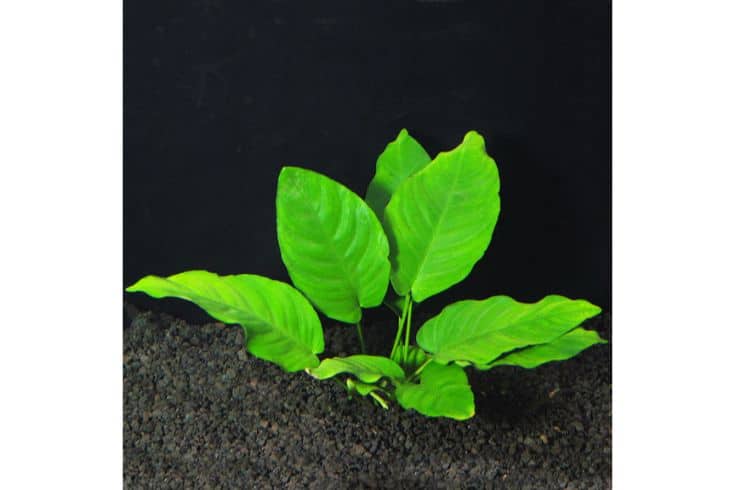
The Anubias Barteri var Nana is a miniature version of its big brother. It has the same thick, round leaves but only grows to about 4 inches in height. Many fishkeepers love using them as foreground plants! Your fish will love resting on its leaves and hiding in its nooks and crannies.
Anubias barteri var Nana Bonsai
These are some of the most unique anubias around, and it’s easy to see why! The leaves of the nana bonsai are clustered around the rhizome and look like tiny little trees. It grows at a very slow rate, but rewards your patience with a plant that’s genuinely one of a kind. Do note that you’ll need to prune this plant strategically for the best results! We think it’s worth all the effort.
Anubias barteri var nana Golden
Anubias barteri var nana Golden is an incredibly attractive, lush plant that offers a beautiful golden hue to aquariums. It has thick round leaves with intricate patterning, and can be used as an alternative or complement to other aquatic plants.
This low-light species grows relatively slowly compared to other varieties of Anubias. This means it won’t outgrow its environment too quickly, which makes this ideal for small tanks and beginners alike!
Anubias barteri var Glabra
Anubias barteri var Glabra is an aquatic plant that has long-stalked, shield-shaped leaves. It is typically found in slow-running freshwater, and is one of the hardiest plants around! It’s easy to care for, can grow in low-light environments, and doesn’t require much fertilizer or other maintenance.
Personally, I find its deep green shade and hardy nature to be quite attractive, making it an excellent choice for aquascaping. Placed in the midground of any aquarium, it’s sure to add a rustic yet classy touch! Its leaves remain rigid even in bright light, so this aquatic plant is the perfect addition to all large or small tanks.
Anubias barteri var Caladiifolia
Anubias barteri var Caladiifolia originated in an Australian lab, but don’t let the clinical nature of its origins throw you off. It’s a beautiful, popular choice for fish tanks and aquariums of all types – perfect for bringing life to any space without breaking the bank, or doing extensive maintenance work!
Its lush dark green leaves are so densely packed, creating an attractive, bouquet-like appearance. An additional bonus? This plant can survive both submersed (underwater) or emersed (out of water), making it an ideal pick if your tank is prone to changes in water level.
Anubias barteri var “Coffeefolia”
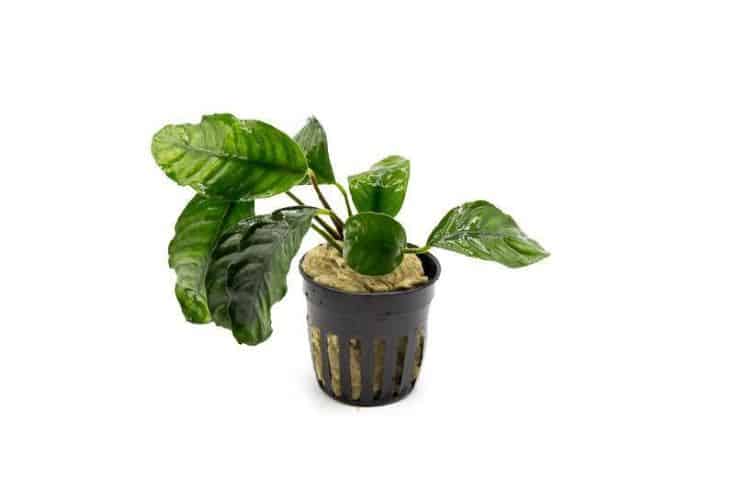
The beautiful Anubias barteri var “Coffeefolia” can grow up to twelve inches tall! We love this aquarium plant thanks to its large and evergreen foliage, which is shades of dark green with hints of coffee brown. It’s the perfect focal point for any underwater environment!
This species grows very slowly in a steady pattern and doesn’t require cutting or pruning often, making it super low maintenance. This makes it ideal for budding aquarists as well as experienced ones! Like other anubias, it only needs medium light and can easily adapt to a variety of temperatures. This eye-catching species is easy on the wallet too. Talk about a win-win!
Anubias barteri var Angustifolia
Anubias barteri var. Angustifolia is a low-maintenance aquatic plant that’s ideal for aquascaping in fresh and brackish aquariums alike! It produces thick rhizome-like roots, which makes it easy to attach to rocks or other décor pieces with just some fishing line.
The attractive, spade-shaped leaves look amazing when displayed in planted aquariums and add great contrast to a variety of substrates. Plus, since it grows so slowly, you can easily keep up with its maintenance. Nobody likes having to prune their plants every week, right? Anubias barteri var. Angustifolia ensures that won’t be a problem!
Anubias gigantea
Anubias gigantea isn’t just another little aquatic plant. This one is special! Native to the tropics, it grows much larger than most anubias species, and can reach up to 2 feet in height – making a real statement when you add it into your planted aquarium set-up.
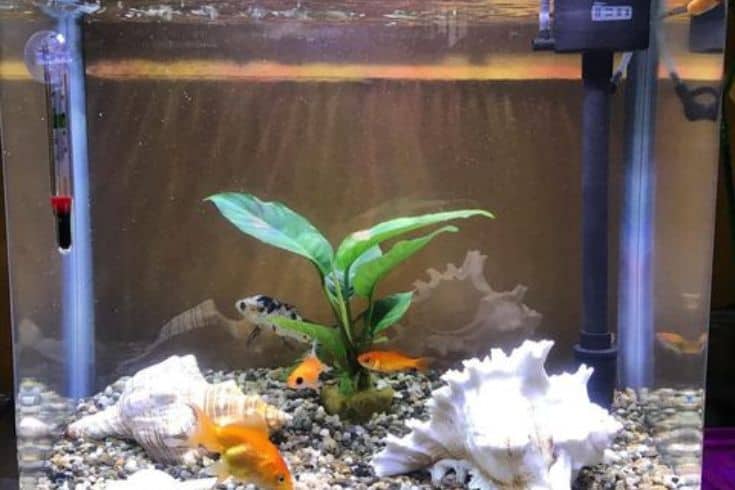
Its huge, dark leaves have almost leathery textures, which give them great durability. The attractive deep green color of its leaves, punctuated by darker veins running through them, provides an instant splash of color to any tank or pond. If you’re looking for a hardy, beautiful accent plant, this might be the perfect fit for you.
Anubias gracilis
Anubias gracilis have gorgeous, triangular leaves that are bright green with dark veins. They create beautiful, wispy clumps and make a great conversation piece for any planted tank set-up! Make sure you give it low-intensity light, or its delicate foliage may suffer from too much brightness. We also recommend planting Anubias gracilis in the shade of taller plants.
Anubias Gilletii
Anubias Gilletii is an aquatic plant that’s as hardy and versatile as they come! It grows well in any kind of freshwater aquarium, even with low lighting. Its long leaves make it a great addition to the middle or background to create a lush atmosphere.
And since this beauty tolerates water flow easily, Anubias works wonders near filters and powerheads too – plus, its slow growth rate means less maintenance for everyone!
Anubias Nangi
Anubias Nangi is an awesome aquatic plant! It has beautiful, bright green leaves with a lovely lobed shape that creates the perfect contrast between your other plants. The fantastic thing about Anubias Nangi is how easy it is to take care of—you don’t need fancy lighting or special substrate as long as you keep the water temperature and pH stable.
This species also doesn’t require too much fertilizer for growth either! Overall, this hardy little plant adds some vibrant color to any freshwater aquarium, and we can definitely recommend having one if you’re looking for a nice statement piece.
Anubias heterophylla
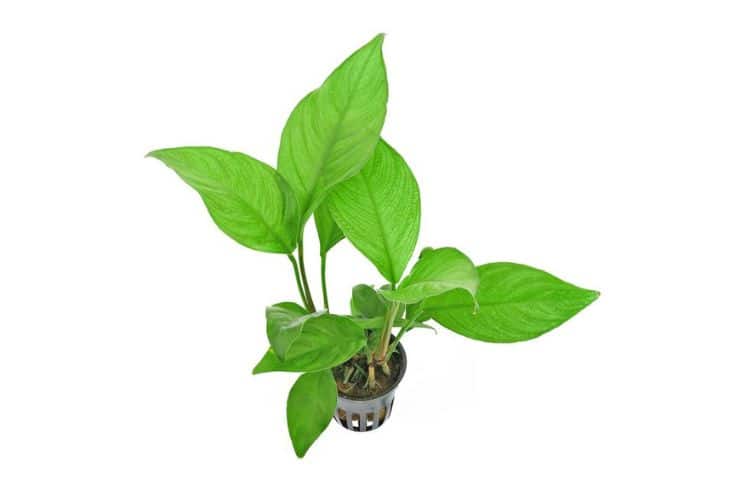
Anubias heterophylla is a great little plant for those new to keeping aquariums. It has gorgeous deep green heart-shaped leaves that add lots of color and interest in any environment! This particular species grows relatively slowly, making it super easy to care for – all you really need are bright but indirect lighting and some regular water changes.
To top things off, Anubias heterophylla can handle different levels of pH, so if your tank’s chemistry isn’t quite perfect yet (we’ve all been there!), then this makes the ideal choice since it won’t suffer from any imbalances or too much stress.
Anubias hastifolia
Anubias hastifolia is a beautiful and unique aquatic plant. It has wide, rounded leaves that create an interesting texture in the water. Its deep green color contrasts beautifully against any vibrant fish you might choose for your tank! This tough species can survive anything from high levels of light to sparse nutrients – it’s very low-maintenance so even beginner aquarists will find success with it!
Anubias Nana Pinto
Anubias nana Pinto is a captivating and unique aquatic plant. This slow-growing species features beautiful green leaves that fan out in every direction, delicately decorated with subtle dark spots. Anubias can reach heights of up to 6 inches when grown properly, making it the perfect addition to any freshwater aquarium!
Planting this beauty requires little effort – simply attach its rhizome section directly onto driftwood or rocks for quick results. If you’re looking for stunning foliage and easy maintenance care requirements all wrapped into one delightful package – go ahead and give Anubias Nana Pino some love!
Anubias Nana Snow White
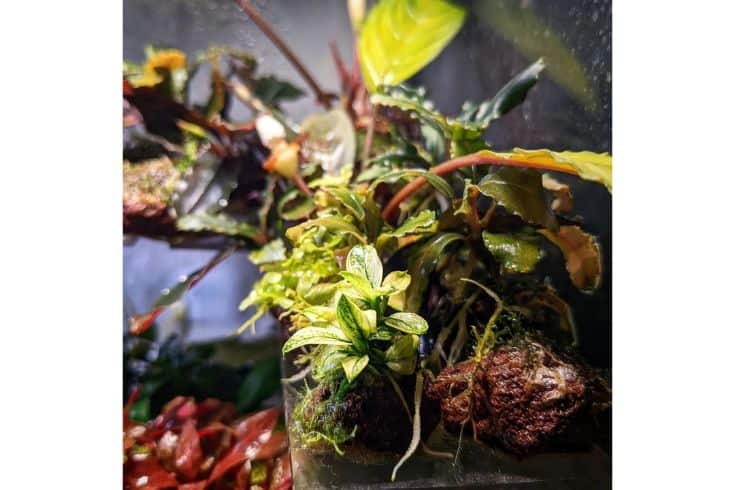
Anubias Nana Snow White is a beautiful and low-maintenance aquarium plant that adds color, contrast, and texture to your tank. Its delicate white leaves give it an elegant appearance, unlike any other aquatic plant. The lobed foliage grows in dense clumps, which look great as foreground or midground decorations!
This hardy species can handle wider ranges of light conditions than most, making it perfect for both beginner aquarists and professionals alike—all you need to do is the occasional pruning so they don’t take over too much space in the tank. Best of all? They’re super easy on water quality parameters since their slow growth rate means fewer demands from their environment!
Choosing A Healthy Anubias Plant
Despite the anubias’ reputation for hardiness, you still want to make sure you select a healthy and vibrant plant. Here’s your easy-to-follow guide on choosing the best anubias for your set-up:
Check The Leaves
The biggest indicator of health in anubias is the leaves. Your healthy plant should have firm, glossy-looking leaves with no yellowing or brown spots on them. If any holes are present, they shouldn’t be too large – inspect to make sure there aren’t massive tears at the edges either.
Although minor spotting on the leaves is normal, you don’t want anything that looks particularly severe. It may indicate issues with pests or diseases, which can weaken and even kill your plant if not addressed quickly. These pests can also infect other aquatic plants, so it’s best to keep your distance.
Assess Its Root System
Anubias need a healthy root system in order to grow and thrive, so it’s important that the roots look somewhat established. The majority of your chosen anubias should have massed up a good amount of fibrous white roots at the bottom, which will give you confidence when adding them to your set-up.
Ideally, you want thick strings here rather than thin reeds – if they’re too skinny, then there may be nutrient deficiencies impacting their growth potential. You should also look at the rhizome, or the central part of the shoots that hold both the leaves and roots. If this is all mushy or dark, then your plant may also have diseases present.
Looking For Healthy New Growth
Lastly, it’s a good idea to look at any new growth in your chosen anubias. If it’s healthy, the new leaves should emerge from a single point at the center of each shoot and look glossy with no spotting or discoloration.
This is an encouraging sign that your anubias may have come out of good quality conditions – although, remember, older plants can still have potentially vibrant growth if cared for properly! Be sure to ask about its origin before buying, so you’re aware beforehand how much love (and light) this plant has been receiving before coming home with you.
How To Propagate Anubias
Have you been keeping your anubias alive and well for some time now? Although these plants are slow growers, odds are, they’ve grown to a decent size if you’ve had them for a while. At this juncture, many seasoned aquarists will recommend propagating your anubias! This process creates multiple clones of your plants, which will look awesome when you spread them out in your tank.
So, how should you go about propagating your anubias? Here’s a quick overview of our preferred method:
Step 1: Prep your workstation
People often forget to sterilize their set-up before taking on a propagation project. Though you will only need a sharp blade and some gloves, you should sanitize them before using them on your anubias.
Why is this important? Well, plants tend to be a little more fragile after propagation. You’re essentially cutting a plant into multiple parts, leaving its insides exposed. Using clean tools minimizes the risks of contaminants entering the plant and ultimately killing it.
Step 2: Remove the anubias from the tank

Gently loosen the anubias from the aquarium substrate using your fingers or a soft-bristled brush. If you’ve attached your anubias to rocks, driftwood, or another decor, remove the entire piece. Then, slowly separate the roots from the rest of the structure.
Finally, carefully detangle the roots. People snag and tug on the roots more often than you’d think, which amplifies the chances of these fragile parts breaking. You’re already subjecting your anubias to a stressful situation, so do your best to avoid any additional strain!
Step 3: Locate the central rhizome
Think of the rhizome as the anubias’ central root system. It’s where the other roots should grow out from, and it feels like a little nodule. Or like a thicker, more solid core within the root system. This is what you’re looking for.
Step 4: Surgery
Okay, that sounds a little intense. But it’s basically what comes next! Using your (sterilized!) blade, you’re going to cut the rhizome into multiple parts. Cut it in two if this is your first time propagating anubias.
In doing so, please make sure the anubias leaves remain attached. Each cut piece of rhizome should have about 3-4 leaves attached.
Step 5: Replant the anubias in different parts of your tank
This is very important! You need to give each new piece of anubias its own space in your tank. This means spreading them apart. It will also give your tank a more lush look, which is a nice bonus.
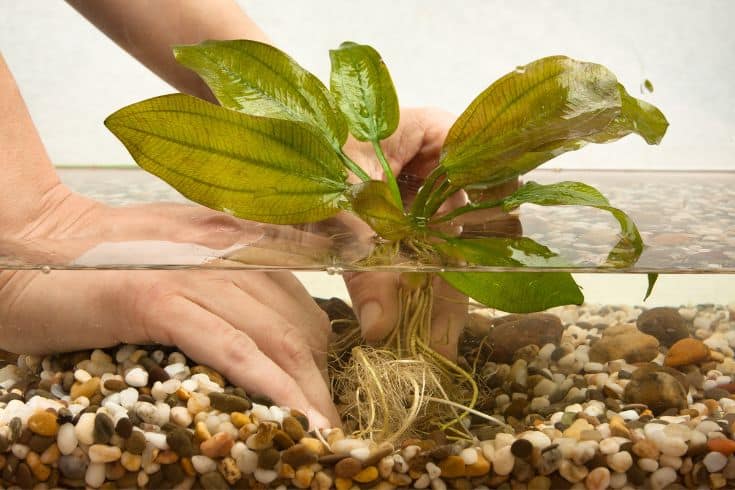
If your original anubias was attached to rocks or driftwood, make sure you have a new structure ready to go for each new cut anubias. Don’t place them all on the same piece of driftwood! The crowding will cause make it harder for your anubias to receive enough light.
Step 6: Sit back and enjoy!
Now that you’ve gotten most of the heavy lifting out the way, it’s time to sit back, relax, and enjoy the sight of your newly propagated plants. Over the course of the next few months, they’ll grow larger and larger. And you’ll be able to repeat the process again!
Caring for Anubias
So we’ve covered common anubias types, and we’ve talked about how to propagate these little guys. But how exactly should you care for them? Is there anything specific this hardy plant needs to thrive? Well, turns out, there are a few things you can do to keep your anubias in tip-top shape:
Keep Algae Growth Under Control
Because anubias are slow-growing plants, you’ll find that algae tend to deposit on the surface of their leaves. If this doesn’t make sense to you, think of it this way: A fast-growing plant undergoes a lot of changes within a short period. Their stems and leaves are constantly moving and changing. This limits the time the algae have to stick to the foliage.
Anubias, on the other hand, are slow-growing. This gives algae plenty of time to stick to the plant’s leaves. These colonies will then spread and cover the surface of every leaf. Suffice it to say, this is not what you want, as it stops your anubias from photosynthesizing. To keep algae growth under control, make sure to plant your anubias in shaded corners of the tank.
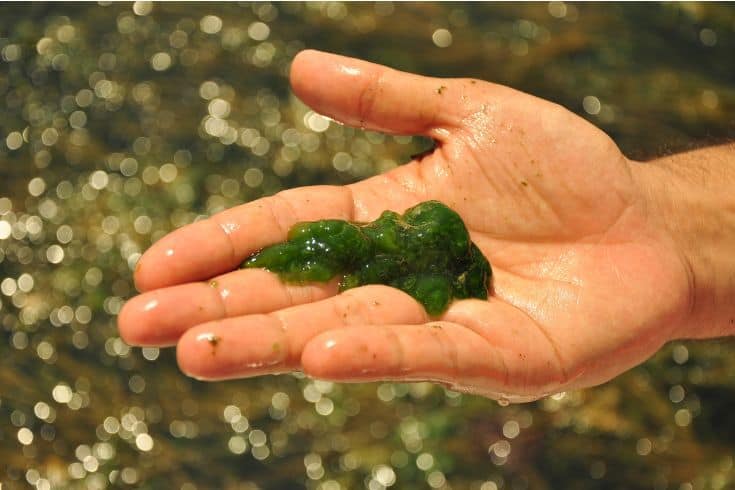
You should also avoid exposing your tank to too much light, because doing so encourages algae growth. Above all, please remove any existing algae from your anubias as soon as possible. Use a toothbrush or algae magnet to carefully scrape away the unwanted growth without damaging the plant leaves.
Using A Nutrient Rich Substrate Helps
Technically, anubias don’t need a substrate. Their roots are versatile enough to absorb nutrients from the water column, or from their immediate surroundings. That being said, planting them in a nutrient-rich substrate can help with their growth.
We recommend using a base layer of aquarium gravel, then topping it off with a soil-based substrate. You want something that will feed its roots and provide them with necessary nutrition. A good example of this is fertilized potting soil, which contains a good mix of nutrients and beneficial bacteria.
The benefits of a nutrient-rich substrate go beyond faster growth and healthier roots. It can also help create beneficial bacteria colonies in your tank, which are essential for the well-being of all aquarium inhabitants. The substrate also makes a great foundation to secure anubias plants so that they stay where you put them.
Avoid Destructive Fish Species
Allow us to be specific. For the purposes of this article, a destructive fish species is one that will harm your anubias by nibbling away at their leaves or roots. While most fish will not inflict serious damage, the little holes and ripped leaves created by some of these fish can be unsightly. Also, some fish can uproot your entire plant, and you don’t want that!
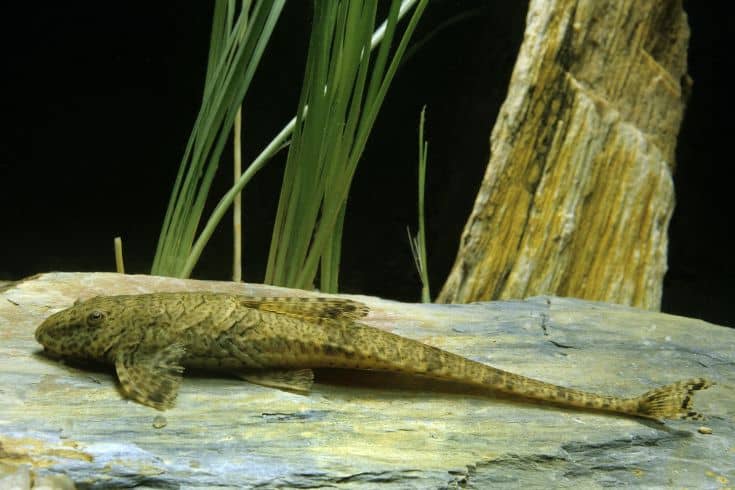
The most common destructive species of fish are herbivores like silver dollar and the common plecos. Clumsier fish such as goldfish, can also wreak havoc if you’re not careful! The takeaway? Do your research before introducing any fish to your tank!
Final Thoughts
So there you have it! We hope this article taught you everything you needed to know about anubias, and why it’s such a great plant to include in your planted aquarium. From its low maintenance upkeep to the beauty of its glossy green leaves – anubias is definitely worth having! The fact that they help with tank upkeep is a nice bonus as well.
Have you ever owned anubias before? What was your experience with it like in the tank? Let us know in the comments below! And if you know someone who might be interested in learning more about anubias, feel free to share this article with them. Thanks for reading, and happy fishkeeping!
